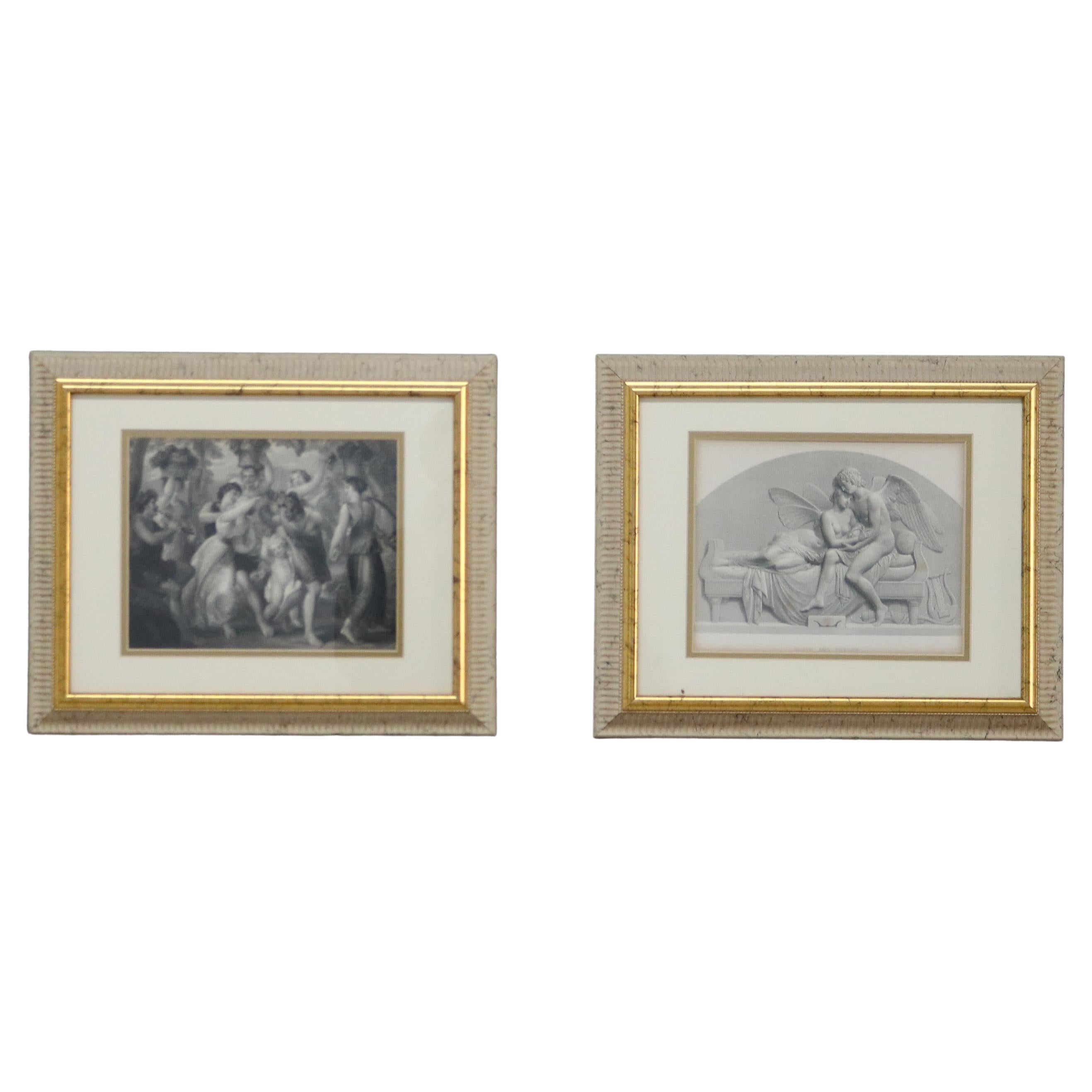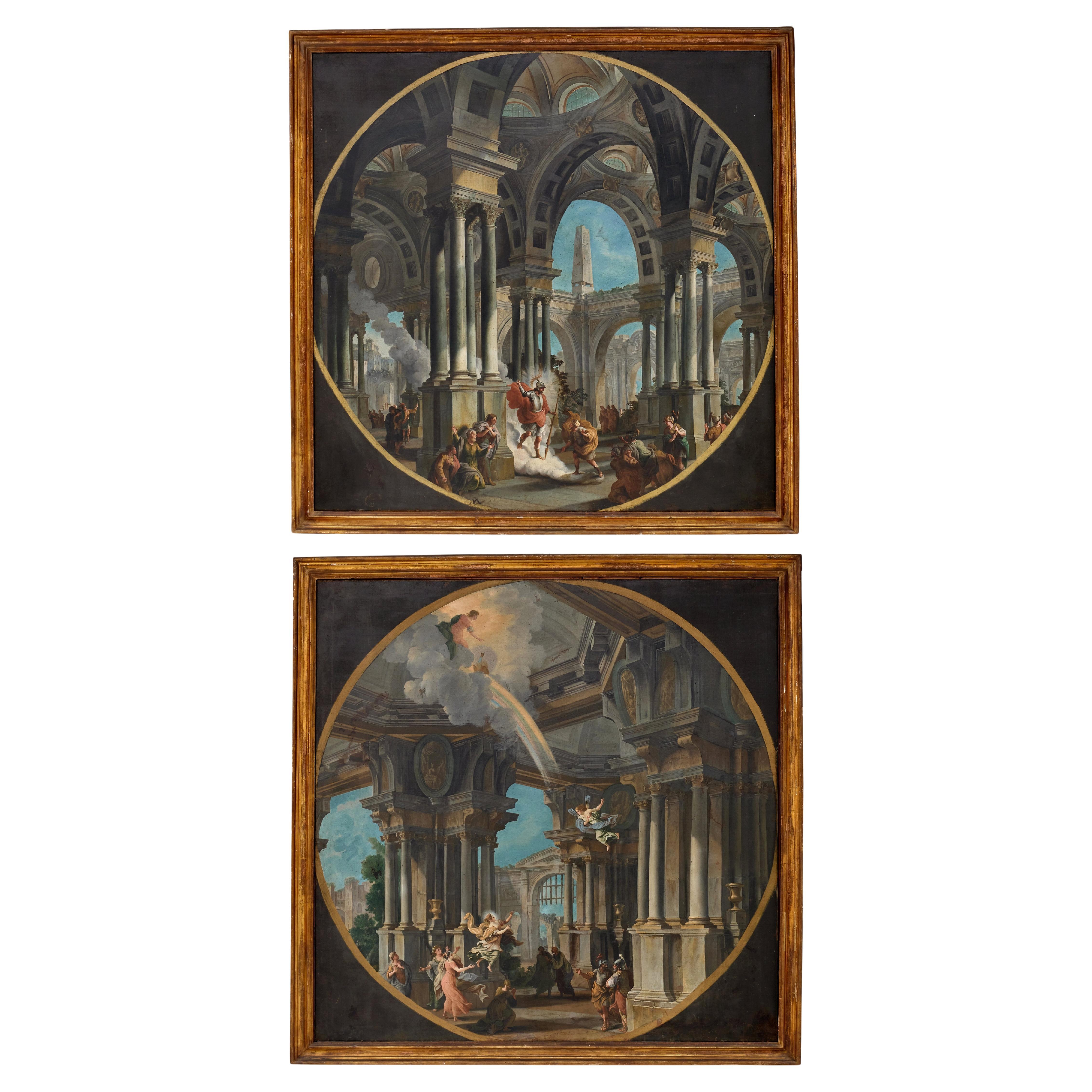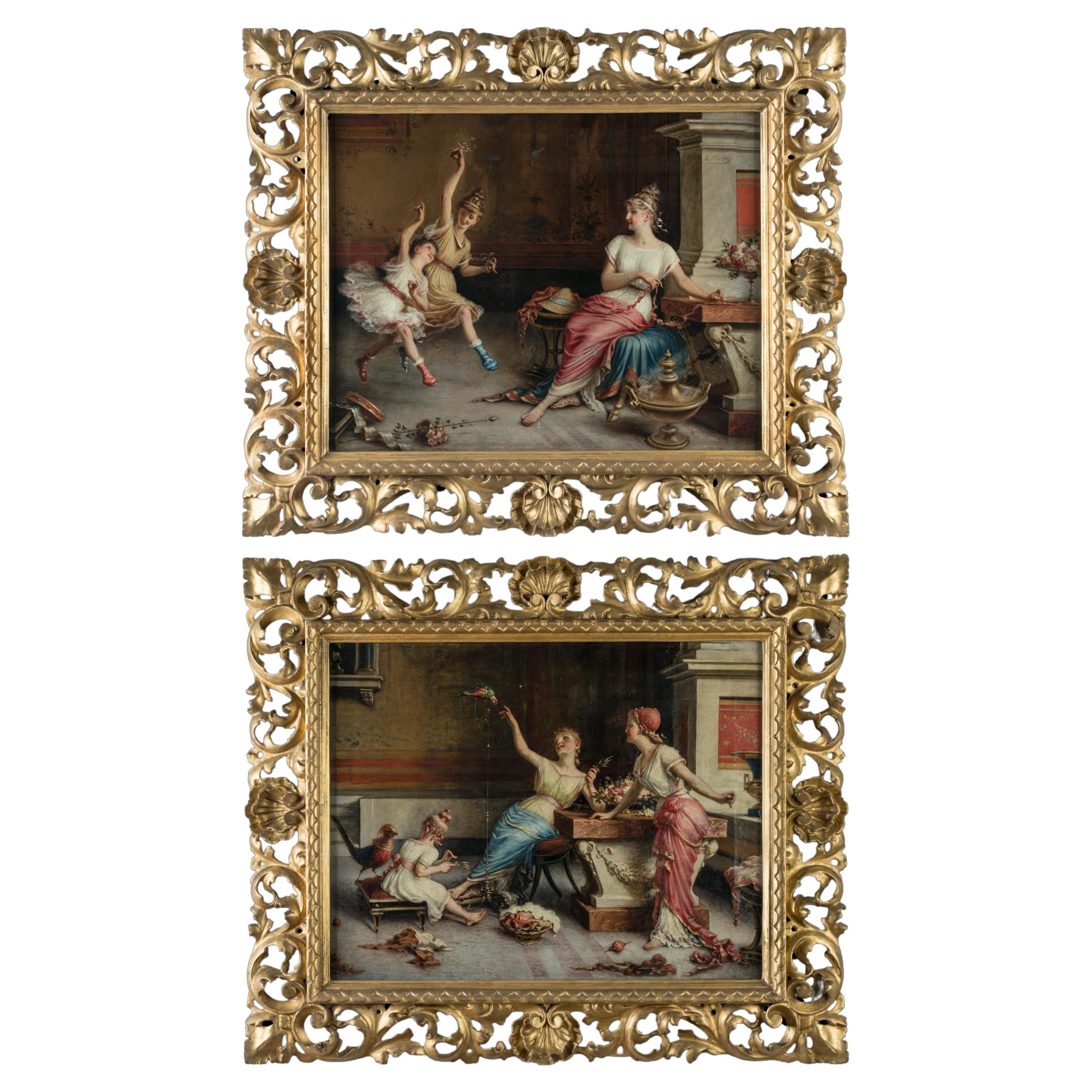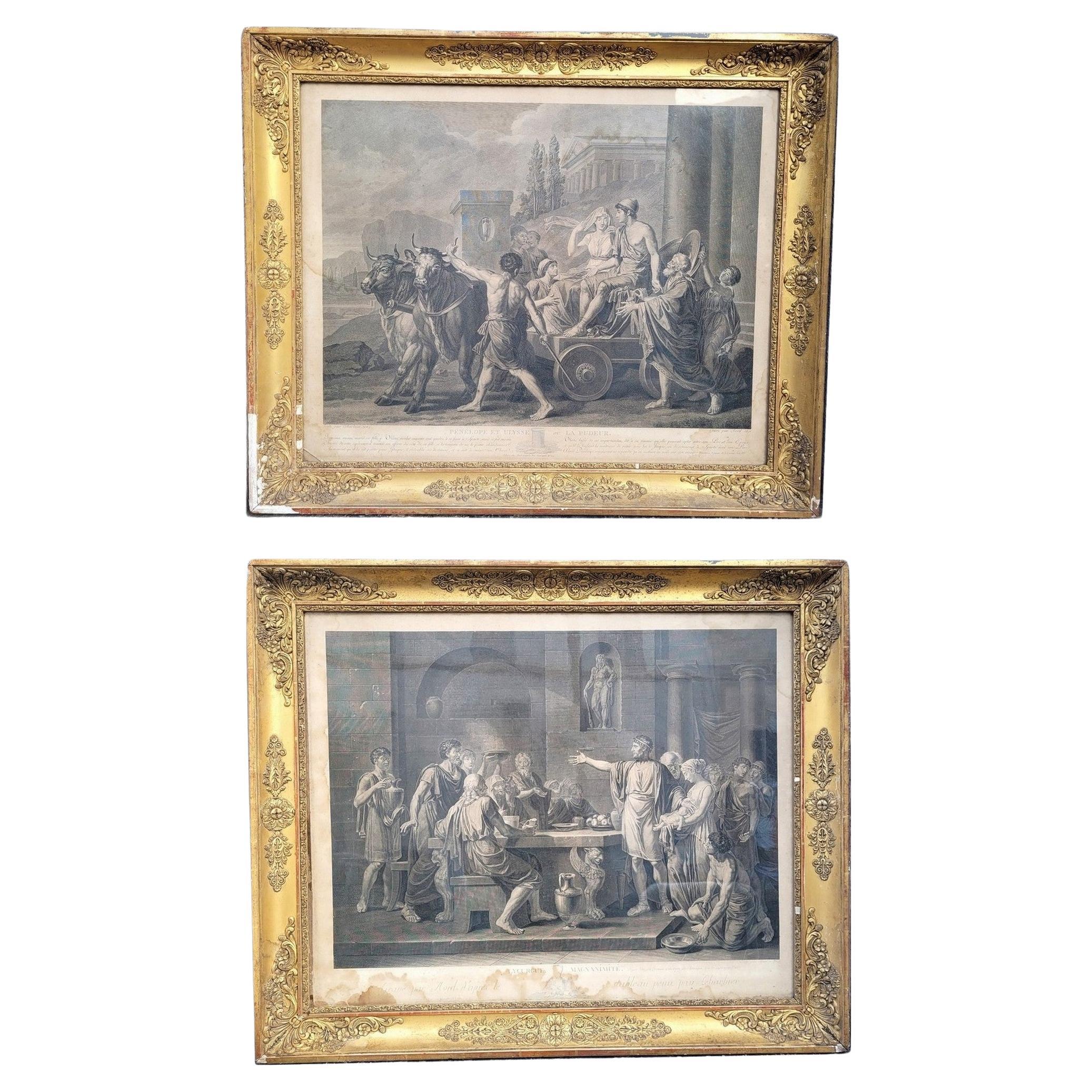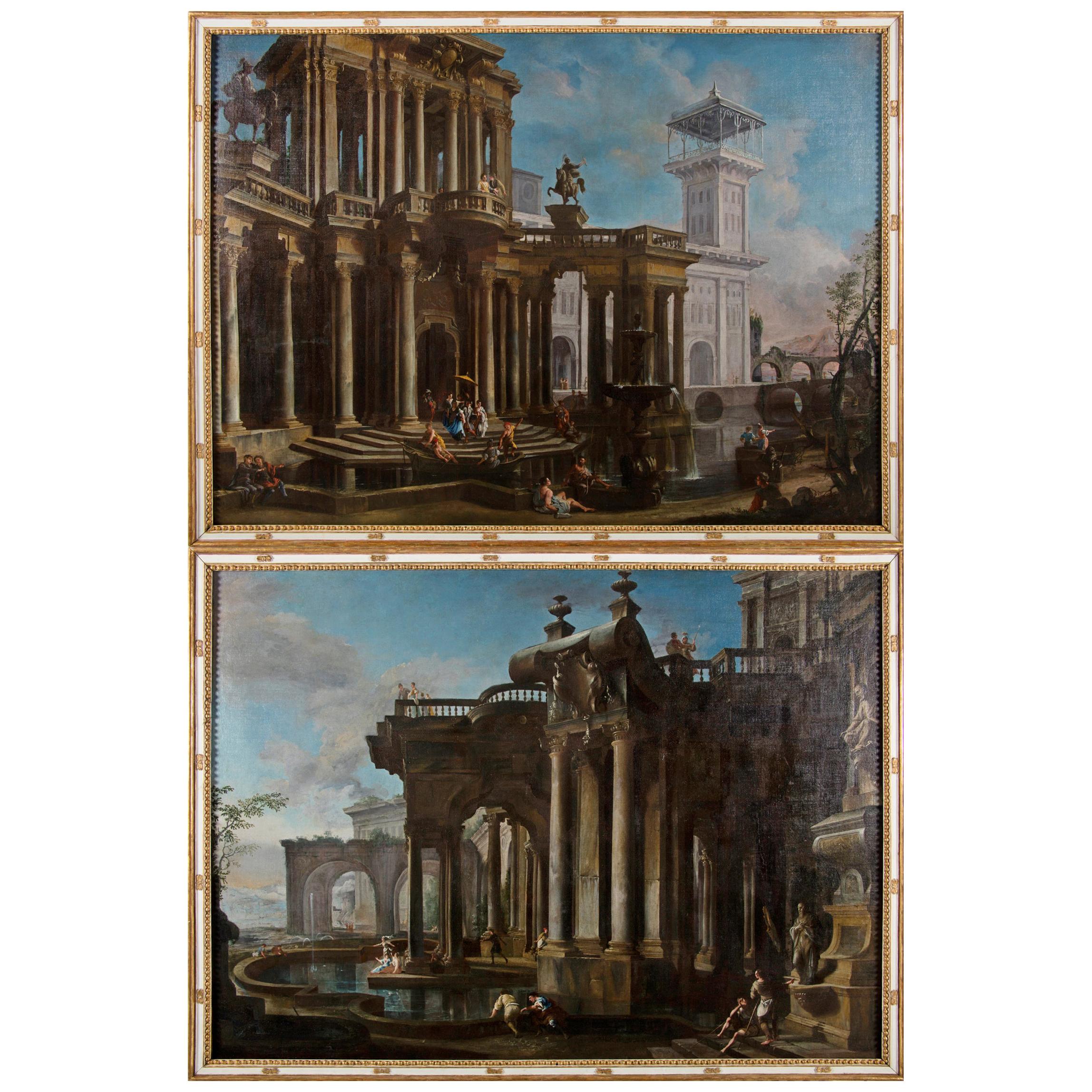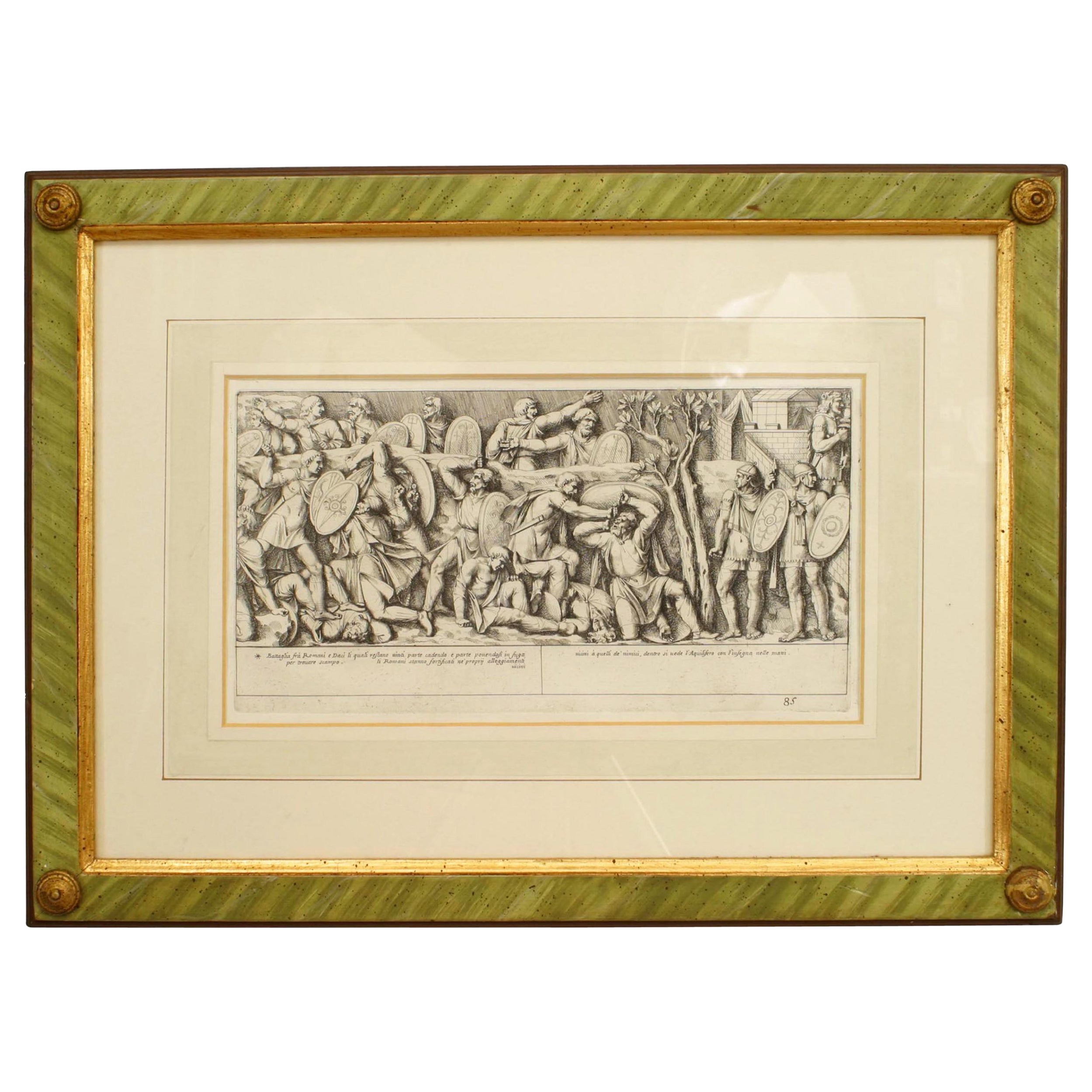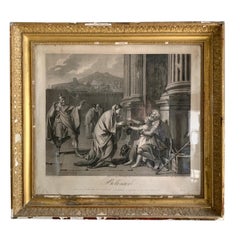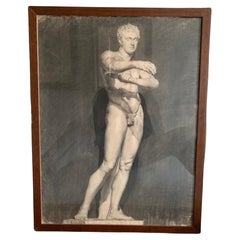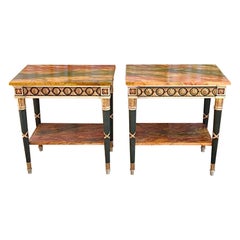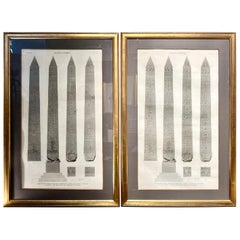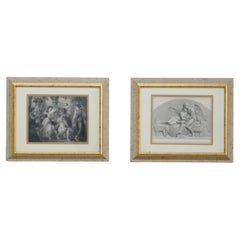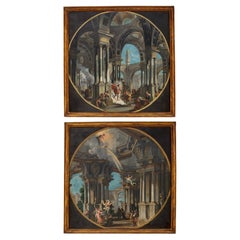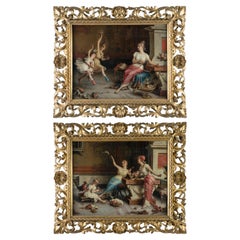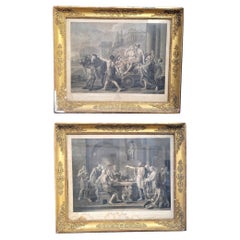Items Similar to 19th Century Pair of Scenes Julios Caesar's Life
Want more images or videos?
Request additional images or videos from the seller
1 of 7
19th Century Pair of Scenes Julios Caesar's Life
$1,901.80per set
$3,565.88per set46% Off
£1,416.25per set
£2,655.47per set46% Off
€1,600per set
€3,000per set46% Off
CA$2,625.70per set
CA$4,923.18per set46% Off
A$2,910.97per set
A$5,458.07per set46% Off
CHF 1,529.83per set
CHF 2,868.43per set46% Off
MX$35,625.52per set
MX$66,797.86per set46% Off
NOK 19,106.01per set
NOK 35,823.78per set46% Off
SEK 17,932.91per set
SEK 33,624.20per set46% Off
DKK 12,181.87per set
DKK 22,841per set46% Off
About the Item
Pair of scenes from the life of Julius Caesar. Made in gouache on paper with antique frame. We have two pair. Signed by Alberto de Benedetti, circa 1849.
- Dimensions:Height: 33.47 in (85 cm)Width: 47.25 in (120 cm)Depth: 0.79 in (2 cm)
- Sold As:Set of 2
- Style:Neoclassical (In the Style Of)
- Materials and Techniques:
- Place of Origin:
- Period:
- Date of Manufacture:circa 1849
- Condition:Wear consistent with age and use.
- Seller Location:Madrid, ES
- Reference Number:1stDibs: LU95431209686
About the Seller
4.8
Gold Seller
Premium sellers maintaining a 4.3+ rating and 24-hour response times
Established in 2012
1stDibs seller since 2012
197 sales on 1stDibs
Typical response time: 1 hour
- ShippingRetrieving quote...Shipping from: Madrid, Spain
- Return Policy
Authenticity Guarantee
In the unlikely event there’s an issue with an item’s authenticity, contact us within 1 year for a full refund. DetailsMoney-Back Guarantee
If your item is not as described, is damaged in transit, or does not arrive, contact us within 7 days for a full refund. Details24-Hour Cancellation
You have a 24-hour grace period in which to reconsider your purchase, with no questions asked.Vetted Professional Sellers
Our world-class sellers must adhere to strict standards for service and quality, maintaining the integrity of our listings.Price-Match Guarantee
If you find that a seller listed the same item for a lower price elsewhere, we’ll match it.Trusted Global Delivery
Our best-in-class carrier network provides specialized shipping options worldwide, including custom delivery.More From This Seller
View All19th Century Empire Period Engraving
Located in Madrid, ES
A large early 19th century Empire period engraving. depicting Belisarius receiving Almas, original ilded frame in classical taste, with original gl...
Category
Antique Early 19th Century French Empire Drawings
Materials
Glass, Giltwood
$855 Sale Price
42% Off
20th Century, Academy Drawing Pencil Paper
Located in Madrid, ES
Drawing Greek sculpture academy made in charcoal at the beginning of the 20th century, at the Spanish academy in Rome. Depicting a Greek sculpture.
Category
Early 20th Century Italian Neoclassical Revival Drawings
Materials
Paper
Pair of 20th Century Neoclassical Hand Painted One Drawer Side Tables
Located in Madrid, ES
Beautiful pair of hand painted bedside tables, with beatiful neocassical desing painted in grey, green and giltwood,the top, as well as a sh...
Category
Mid-20th Century Spanish Neoclassical Revival Side Tables
Materials
Fruitwood, Giltwood
19th Century Pair of Engravings of "Description of Egypt"
Located in Madrid, ES
Two engravings from the book "The Description of Egypt", a major publication by the scholars who accompanied Napoleon, which included descriptions and engravings made by these schola...
Category
Antique Early 19th Century French Empire Drawings
Materials
Wood, Paper
19th Century Pair of Grand Tour Socrates and Septimio Severo Busts
Located in Madrid, ES
Pair of Italian busts from the Grand Tour, representing the Greek philosopher Socrates and the Emperor Septimius Severus, sculpted in bronze, with a chiseled bronze base and marble c...
Category
Antique Late 19th Century Italian Grand Tour Busts
Materials
Marble, Bronze
Chinese Export Six Panels Lacquered Screen
Located in Madrid, ES
Chinese screen for export with 6 panels decorated on both sides. The front side with various scenes of daily palatial life with relief figures, buildings and landscapes made of pain...
Category
Early 20th Century Chinese Chinese Export Screens and Room Dividers
Materials
Brass
$3,328 Sale Price
20% Off
You May Also Like
Pair of Antique Neoclassical Genre Scene Prints, Framed, C1890
Located in Big Flats, NY
Pair of Antique Neoclassical Genre Scene Prints, Framed, C1890
Measures - 13.75"H x 16.5"W x 1.25"D
Category
Antique 19th Century Prints
Materials
Wood
$520 Sale Price / set
20% Off
18th century, Couple of Italian Paintings Capriccio with Mythological Scenes
Located in IT
Couple of architectural capriccio with mythological scenes, oil on canvas, painter from Bologna active in the 18th century
The two large and valuable pantings depict two architectur...
Category
Antique Early 18th Century Italian Baroque Paintings
Materials
Canvas
A Pair of Oil on Canvas "Pompeian" Interior Scenes by Egisto Sarri of Florence
Located in London, GB
A Pair of "Pompeian" Interior Scenes
By Egisto Sarri of Florence
Executed in oil on canvas, and housed in matching hand-carved giltwood frames, depicting intimate domestic life of t...
Category
Antique 19th Century Italian Paintings
Materials
Canvas, Giltwood, Paint
Pair of Framed Neoclassical Engravings, Late 18th Early 19th century
Located in MARSEILLE, FR
Pair of framed neoclassical engravings, after works painted by Jean Jacques François Le Barbier (1738 - 1826) and engraved by Jean-Jacques Avril (1744-1831), dated 1789 for the paint...
Category
Antique Late 18th Century French Neoclassical Prints
Materials
Wood, Paper
Couple of Italian Paintings Depicting Capricci, Francesco Aviani ‘1662-1715’
Located in IT
Francesco Aviani (Italy - Venice, 25-11-1662 / 1715) att.
Couple of paintings depicting Capricci
Oil on canvas, 135 x 183 cm, without frame
The two large and fine paintings depict two illusionistic architectural renderings, with views of colonnades and arched buildings, animated by figures. The compositions are characterized by the harmony with which the painter introduces the sumptuous architectural monuments, the mirrors of water, the buildings in the distance and the views of the landscape. Dominates with a color on the tones of brown and ochre that stands out on the blue sky, marked by some cloud of steam. The insertion of the figures to enliven the architectural views also balances with the set.
The Capriccio, an artistic genre that has made its way into Italian painting since the 17th Century, is characterized by the representation of fantastic architectures or prospective inventions, sometimes combined with elements drawn freely from reality. The two paintings are an example of this type and they are a very interesting and Fine artwork.
The remarkable pictorial quality emerges both from the composition of the ensemble and from the way in which the artist describes the views with great attention to detail, highlights and refined, perfectly realistic, chiaroscuro.
The same must be recognized for the figures: these are described with a wise brushstroke, quick and quick touches give the dynamism of the moment that is captured, as if time had stopped to show and narrate what is happening.
The painting on the right represents a large Baroque building in stone and paved with marbles, two floors, with moving façade, large columns with corinthian columns, a large portal with a staircase with large footsteps, a balustrade with string, from which some figures appear, and two equestrian monuments in bronze. The sumptuous building overlooks a large POOL of water, with a gushing fountain, around which some characters sit. In the second floor is described a white palace from which rises a tower crowned by a structure with wrought iron loggia. In addition there is a bridge and some architectural ruins behind which some mountainous reliefs fade towards the horizon.
On the staircase is described a particular scene. The people seem to be part of a very precise story. A woman, in the shadow of a parasol supported by a servant, would seem to drive out of the palace a man, who, taken under his arm by two maidens with a determined attitude, is led to a boat.
The scene could be identified with the biblical episode of the parable of the prodigal son (Luke 15,11-32), at the moment when the prodigal son is robbed and driven away by the harlots.
The episode tells of a man with two children. The youngest said to his father: “Father, give me the part of my inheritance”. And the father divided the substances. After not many days, the youngest son, collected his things, left for a far country and there he lost his substances with prostitutes and living as a debaucher. When he had spent everything, there came a great famine in that country and he began to find himself in need. Reduced to hunger, he was forced to be a pig herder to survive. He therefore meditated in his heart to go to his father and ask for his forgiveness and to be welcomed anew, even as a servant.
While still on the road, however, the father saw him and ran towards him, receiving him with open arms. He then ordered his servants to prepare a great feast for the occasion, killing for the purpose the "fatty calf". The firstborn did not understand why his brother was given such treatment, and reminded the parent that he, who had always obeyed him, had never received a single kid to celebrate with his friends. The father answered him: «Son, you are always with me and everything that is mine is yours; but it was necessary to celebrate and rejoice, because this brother of yours was dead and came back to life, was lost and was found».
The parable of the prodigal son was often portrayed in painting and the scene he finds most is certainly that of returning home in his father’s arms. Among the many is a canvas by the famous painter Giovanni Paolo Pannini (or Panini) (Italy – Piacenza, 1691– Rome, 1765) kept at the Hallsborough Gallery in London.
Rather rare, however, is the scene of the prodigal son driven and robbed by harlots. There is an engraving by Hans Collaert II (1561-1620) in which this moment is described in the background compared to the moment, narratively later, in which he is penitent among the pigs.
The second painting, certainly pendant of the first, represents a similar palace, with some characters overlooking the balustrade marcapiano and other figures around the large bathtub quadrilobata. In the foreground is described a monument with two large stone sculptures. In the distance some architectural elements and, beyond, the mountains are lost on the horizon.
The studies related to the numerous painters of architectural views and caprices, active in Italy, and the archival documents found, which could better clarify commissions, biographies and certain works, are scarce and sporadic. Therefore there are still many difficulties in reconstructing a catalogue of autograph works for each author. Through paintings in private collections, in museums and paintings passed on the antique market it is however possible to advance some attributions in order to better delineate the various artistic figures.
The style of the works studied here leads to a dating that runs between the 17th and 18th Centuries, with obvious influences dictated by the perspectives of the brothers Galli Bibiena. The analysis of the architectures and the chromatic palette suggests that we are in the presence of a northern Italian and Venetian author. Observing the decorations and the volutes, the brightness and the perspective disposition in fact, we find several analogies with those used by the Vicenza painter Francesco Aviani, excellent in pictorial perspective and architectural views.
The biographical profile of Francesco Aviani (Italy - Vicenza, 1662-1715) was essentially traced in 1956 by Andreina Ballarin, then re-visited by Federica Spadotto in 2014 and Giancarlo Sestieri in 2015. Certain documents about his life are scarce, as are the documented works.
He was born in Venice, probably on 25 November 1662, to Bernardo and a Magdalene whose surname is unknown, and was baptized on 3 December 1662. Between 1701 and 1703 he worked, together with his brother MarCo, sculptor, for the fresco decoration (now illegible) of the church villa in Soella (Vicenza). On October 16, 1703 he married Isabella Carcano. On March 26, 1715 he made a will and died on April 3 of the same year, in Vicenza.
The frescoes in the refectory of the sanctuary of Monte Berico in Vicenza are considered authentic works by Aviani, probably made in 1708; the paintings preserved in the Civic Museum of Vicenza: “Landscape with Lazzaro and the rich Epulone”; “Christ among the doctors”; “The miraculous fishing”, works not datable but with attribution corroborated by style. In addition, the frescoes in the east and west corridors of the Villa La Rotonda, near Vicenza; the fresco in the apse basin of the chapel of the church S. Croce, Vicenza, now destroyed; the frescoes of the central hall of Villa Camerini a Montruglio (1714) and a painting of a “Porto Regio”, of which we have a print engraved by Dall'Acqua.
From his works emerges the artistic background that animated the Venetian culture in the early eighteenth century. The scenic grandeur with which Aviani treats the architecture also suggests a stay in Emilia of the painter, in which he could have come into contact with the environment of the Bibiena. These contacts would be confirmed by the press of Cristoforo Dall'Acqua (Vicenza 1734-1787), “Il porto regio”, after a painting of Aviani. The press was part of a group of engravings, representing royal buildings, reproducing paintings of the Bibiena. In the eyes of Dall’Acqua, therefore, Aviani’s work was not foreign among those of the Emilians.
Inside the sumptuous architectural whims, Aviani often depicts biblical scenes, in which the characters share the space and the narrative rhythm, along with figures drawn from everyday scenes, memories of the Veronese and Bassano heritage. Also in the works covered by this study the author does not seem to want to give up a biblical subject, though the purpose of the paintings appears to be clearly a staging scenography-architectural within which the characters are relegated to the role of extras.
From the examination of the architectural Capriccio gathered under the name of Aviani then emerge common elements. The comparison between these works and the works in question highlights the proximity of the compositions. The imposing and scenic architectures are in fact equally characterized by the perspective-scenographic ability diffused in emilian “quadraturisti” and in Bibiena work. In fact, you can see the spectacular slender architecture in the lower part, the loggias that create chiaroscuro games with arches and binate columns placed on massive bases and overhung by projecting cornices.
Significant also the comparison with two paintings with architectural whims in a night vision attributed to Francesco Aviani.
In Aviani’s works it is possible to find a certain knowledge of the Roman Codazzi paint nd its early development of the eighteenth century, developed with the Locatelli, the Pannini and the less known Domenico Roberti. To Roberti have been recently attributed two works that have some compositional affinity with the canvases in question. The same can be done for a work on the antique market, attributed to Pietro Francesco...
Category
Antique Late 17th Century Italian Baroque Paintings
Materials
Canvas
Neo-Classic Roman Historical Scene Print
Located in Queens, NY
Italian Neo-classic style prints of various ancient Roman historical scenes matted in a green painted and gold trim frame (part of a set of 15; associated pieces: 040102A-O)
Category
20th Century Neoclassical Paintings
Materials
Paper
More Ways To Browse
Painting Of A Woman In Blue Dress
Chicago Used Hotel Furniture
Off The Wall Antiques
Antique Luce Furniture
Colonial Peru
Swiss Bank
Enamel Plaque Painting
Antique Wall Registers
Capriccio Painting Italy
German Texas
Oval Floral Paintings
Vintage Floral Oil Painting
19th Century Virgin Oil Paintings
Old Man Of The Sea
Richmond Virginia
Used Mid Century Modern Furniture Seattle
Chinese Ancestor Painting
Mount Vesuvius
